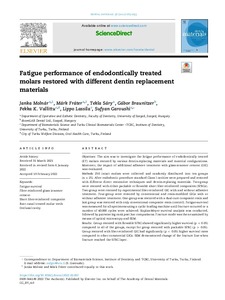Fatigue performance of endodontically treated molars restored with different dentin replacement materials
Molnár Janka; Fráter Márk; Sáry Tekla; Braunitzer Gábor; Vallittu Pekka K; Lassila Lippo; Garoushi Sufyan
https://urn.fi/URN:NBN:fi-fe2022030221520
Tiivistelmä
Objectives: The aim was to investigate the fatigue performance of endodontically treated (ET) molars restored by various dentin-replacing materials and material configurations. Moreover, the impact of additional adhesive treatment with glass-ionomer cement (GIC) was evaluated.
Methods: 250 intact molars were collected and randomly distributed into ten groups (n = 25). After endodontic procedure standard Class I cavities were prepared and restored with different direct restorative techniques and dentin-replacing materials. Two-group were restored with either packable or flowable short fiber-reinforced composites (SFRCs). Two-group were restored by experimental fiber-reinforced GIC with and without adhesive treatment. Four-group were restored by conventional and resin-modified GICs with or without adhesive treatment. One-group was restored with a dual-cure composite resin and last group was restored with only conventional composite resin (control). Fatigue-survival was measured for all specimens using a cyclic-loading machine until fracture occurred or a number of 40.000 cycles were achieved. Kaplan-Meyer survival analysis was conducted, followed by pairwise log-rank post hoc comparisons. Fracture mode was then examined by means of optical microscopy and SEM.
Results: Group restored with flowable SFRC showed significantly higher survival (p < 0.05) compared to all of the groups, except for group restored with packable SFRC (p > 0.05). Group restored with fiber-reinforced GIC had significantly (p < 0.05) higher survival rates compared to other commercial GICs. SEM demonstrated change of the fracture line when fracture reached the SFRC layer.
Significance: Direct restoration of Class I in ET molars with the use of SFRCs as dentin-replacing materials demonstrated its ability to reinforce the dental structures and to increase the fatigue resistance in this specific clinical situation.
Keywords: Fatigue survival; Fiber-reinforced glass ionomer cement; Occlusal cavity; Root canal treated molar teeth; Short fiber-reinforced composite.
Kokoelmat
- Rinnakkaistallenteet [27094]
